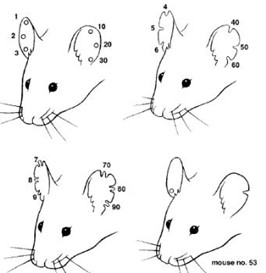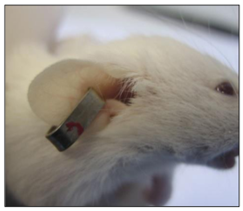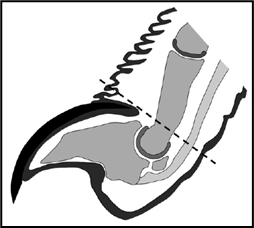IG022: Guideline on Rodent Identification
IACUC Guideline Number: IG022, Approved By: IACUC, Approval Date: 2/8/2024, Version: 3
The Animal Care Program has developed the following guideline to provide information regarding commonly used rodent identification techniques to the research community. It is the responsibility of the Principal Investigator (PI) to review their individual IACUC Animal Use Protocols to determine which method of identification is approved for use.
Definitions
- Ear-punching: Application of a specific combination of small hole punches or notches to the outside edges of a rodent’s ear (see Appendix, Figure 1).
- Ear-tagging: Attachment of a metal or plastic tag with a unique identification number or code to the base of a rodent’s ear (see Appendix, Figure 2).
- Microchipping: Injection of a small microchip transponder subcutaneously between the shoulder blades of the rodent. The microchip is read by use of a scanner.
- Microtattooing: A permanent mark made using needle and ink, which is applied to the tail, toes, ears, or foot pads. Manual or electric equipment can be used.
- Toe-clipping: Procedure in which the most distal bone of the toe (3rd phalanx) is removed (see Appendix, Figure 3).
- As a method of identification of small rodents (mice and rats) toe clipping must only be performed on neonates 5-7 days of age.1,2,3,4,5
- Written justification for toe clipping must be approved by the IACUC before the procedure can be performed. No more than 2 toes per foot should be removed, with a maximum of 6 total clipped toes per animal.
- Non-permanent methods of identification: These methods of identification include fur clipping or the application of non-toxic fur dyes or marker marks. While non-invasive, these techniques are temporary and are only appropriate for short term identification purposes.
Training
Only trained personnel can perform identification techniques We strongly suggest that animals undergoing permanent identification procedures be anesthetized until the individual performing the procedure is proficient enough to perform the technique on conscious animals.
Specific training sessions for rodent identification methods can be arranged through the CAR Training Department; please send requests for training by email to cartrain@msu.edu for further information.
References
- National Research Council, Guide for the Care and Use of Laboratory Animals, 8th ed, pg 75
- Wang L. A primer on rodent identification m Lab Anim (NY) 2005: 34, 64–7
- Castelhano-Carlos, MJ, Sousa N, Ohl, F, and Baumans, V. Identification methods in newborn C57BL/6 mice: a developmental and behavioural evaluation. Lab Anim 2010: 1-16.
- Schaefer, D, Asner, IN, Seifert, B, Burki, K, and Cinelli, P. Analysis of physiological and behavioural parameters in mice after toe clipping as newborns. Lab Anim 2009: 1-7.
- Dahlborn, K, Bugnon, P, Nevalainen, T, Raspa, M, Verbost, P, Spangenberg, E. Report of the Federation of European Laboratory Animal Science Associations Working Group on animal identification. Laboratory Animals. 2013: 47, 2-11.
Other helpful resources
- Waalkes, MP, Rehm S, Kasprzak, KS, and Issaq, HJ. Inflammatory, proliferative, and neoplastic lesions at the site of metallic identification ear tags in Wistar [Crl:(WI)BR] rats. Cancer Research. 1987: 47, 2445-2450.
- Kitagaki, M and Hirota, M. Auricular chondritis caused by metal ear tagging in C57BL/6 mi Vet Pathol 2007: 44, 458-466.
- Kitagaki, M and Shibuya, K. Nylon ear tags for individual identification of guinea pigs. Contemp Top Lab Anim Sci 2004: 43, 16-20.
- Stewart, K and Schroeder, VA. JoVE
- Rodent Identification 1: http://ezproxy.msu.edu/login?url=https://www.jove.com/v/10189/rodent-identification-i
- Rodent Identification 2: http://ezproxy.msu.edu/login?url=https://www.jove.com/v/10182/rodent-identification-ii
Permanent Rodent Identification Techniques
| Method | Age | Anesthesia Requirements | Additional Information |
|---|---|---|---|
| Ear-punching | 14 days or older, due to ears being large enough for a biopsy | No anesthesia is required when performed by trained personnel |
|
| Ear-tagging | 14 days or older, due to ears being large enough to sustain the affixed tag | No anesthesia is required when performed by trained personnel |
|
| Microchipping | Should be performed on animals >7 days old, preferably performed after weaning. | No anesthesia is required when performed by trained personnel |
|
| Microtattooing | Neonates | No anesthesia is required when performed by trained personnel |
|
| Microtattooing | Adults | Anesthesia is recommended but not required |
|
| Toe-clipping | Neonatal mice and rats only; preferably between 5-7 days when toes have separated from the paw | No anesthesia is required; topical vapocoolant is not permitted |
|
Appendix
Figure 1. Commonly used numbering scheme for mouse ear punches. From AALAS Learning Library http://www.aalaslearninglibrary.org.

Figure 2. Correct placement of a metal ear tag. (Brown University. Rodent Identification Policy. 2020).

Figure 3. Proper technique for toe clipping requires removal of the entire most distal toe bone (3rd phalanx) and nailbed, which often requires removal of a small portion of the 2nd phalanx. (Adapted from Dahlberg, et al, 2013).


